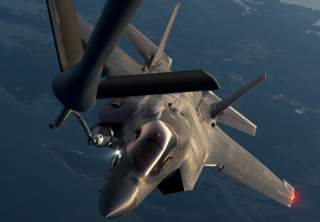South Korea Is Getting New Destroyers, Submarines and Maybe F-35s on 'Aircraft Carriers'?
The South Korean government on April 30, 2019 approved plans to acquire new destroyers and submarines for the country’s fast-growing navy.
The South Korean government on April 30, 2019 approved plans to acquire new destroyers and submarines for the country’s fast-growing navy.
The $6-billion acquisition includes three Aegis destroyers armed with ballistic-missile interceptors and three submarines equipped with their own launchers for land-attack missiles.
The new ships could help Seoul’s navy to expand beyond its current, largely coastal mission. The main threat to South Korea is North Korea, specifically the North’s huge force of artillery that in wartime quickly could demolish Seoul and endanger millions of people.
But looking beyond the North Korean threat, South Korea clearly has ambitions to develop a far-sailing “blue-water” navy. There has been unofficial talk of the South Korea fleet embarking F-35 stealth fighters aboard its amphibious assault ships, in essence transforming the vessels into light aircraft carriers.
The South Korean navy in 2019 operates 68 major warships including 16 submarines, 12 destroyers, 13 frigates, 13 corvettes and 14 amphibious warfare ships. The fleet also includes scores of patrol boats, mine-warfare vessels and auxiliaries.
The three new Sejong the Great-class destroyers and three new Dosan An Chang-Ho-class submarines apparently will expand the fleet rather than replace older vessels.
“The new Aegis destroyers will be outfitted with an upgraded missile launch system which will allow them to intercept ballistic missiles,” Yonhap news agency reported. “They will also represent a marked upgrade in detection and tracking abilities.”
The navy currently possesses three of the Sejong the Great-class destroyers that it acquired between 2008 and 2012. The 11,000-ton-displacement destroyers are among the most heavily-armed in the world and boast 128 vertical missile cells for SM-3 air-defense missiles and Hyunmoo-3C cruise missiles.
At present the American-made SM-3 is most effective as a terminal- or boost-phase missile-interceptor, meaning it possess the speed, range and altitude performance to hit enemy ballistic missiles when they’re first launching or in their final seconds of flight.
But the U.S. Missile Defense Agency plans to modify the SM-3 and test it for the most difficult, mid-course-phase intercepts, when an interceptor must climb outside of the atmosphere. Exo-atmospheric interceptions require special sensors and other capabilities.
Among Asian powers, Japan too is equipping its destroyers with SM-3s for missile-defense missions.
South Korea however is unique in fitting its submarines with launchers for ballistic land-attack missiles. The 3,400-ton-displacement Dosan An Chang-Ho-class subs will come with vertical launchers that can fire Chonryong cruise missiles and Hyunmoo-2 ballistic missiles.
The boats’ land-attack capabilities could help Seoul to target Pyongyang’s 13,000 artillery pieces, potentially minimizing the damage that North Korea could inflict on the south.
More than 30 million people including hundreds of thousands of foreigners live within range of North Korea's artillery. Barrages in the opening hours of a full-scale war could kill or injure 250,000 people, the U.S. Defense Department estimated.
The new submarines during wartime also would hunt North Korea’s own large but aging fleet of subs. Pyongyang operates around 70 undersea vessels, including around 20 Soviet-designed Romeo-class attack boats and scores of midget submarines.
While the South Korean navy optimizes many of its ships for combat on and around the peninsula, the government in Seoul clearly has ambitions eventually to project power across the Pacific region, potentially in close coordination with the U.S. military.
Lt. Gen. Lewis Craparotta, the commander of U.S. Marine Corps Forces Pacific, told reporters there's no reason vertical-landing F-35B stealth fighters couldn't operate from the South Korean navy's Dokdo- and Marado-class assault ships.
The 19,000-ton-displacement Dokdo, which entered service in 2007, is one of South Korea's largest warships. Sister ships Marado is under construction. Dokdo normally embarks an air wing composed of as many as 10 helicopters.
There have been reports that Seoul also wants to acquire its own F-35Bs. John Pike, a U.S. military analyst, told CNBC the F-35B would give the South Korean fleet an air-defense capability "that you wouldn't want to mess with."
David Axe serves as Defense Editor of the National Interest. He is the author of the graphic novels War Fix, War Is Boring and Machete Squad.

